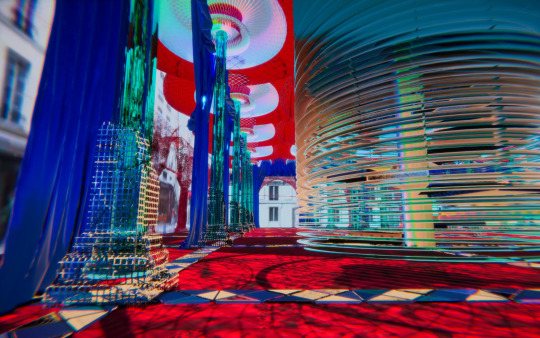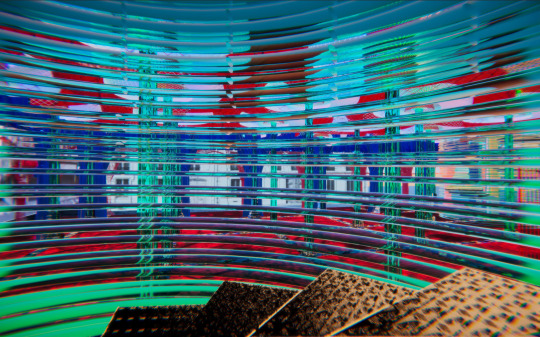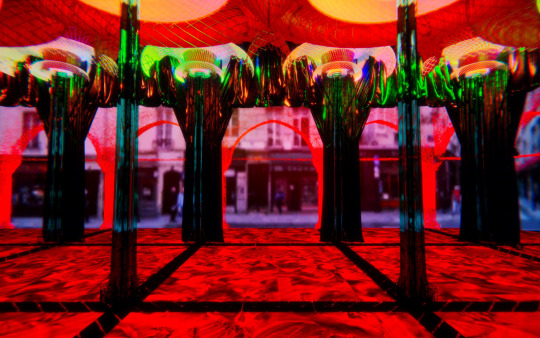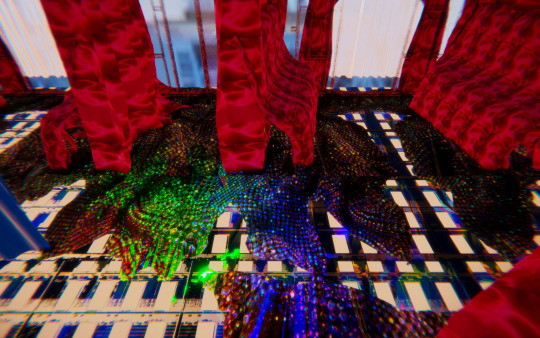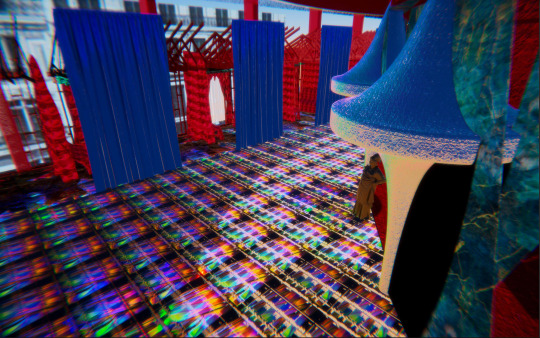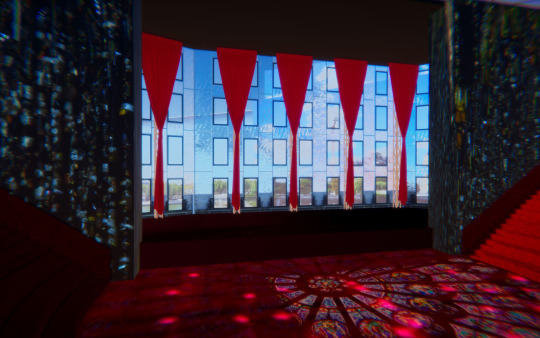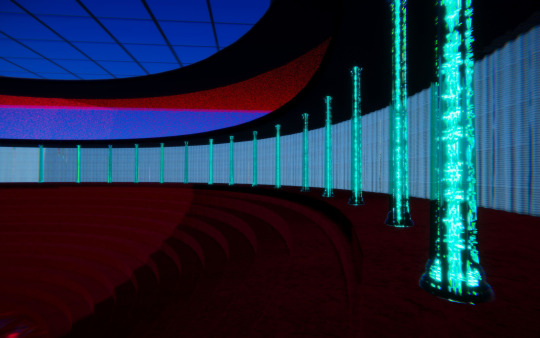#gaadc
Photo


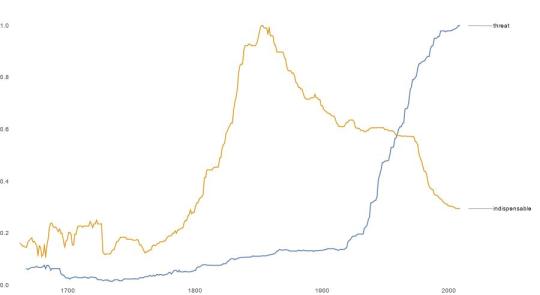
Metis
the goddess swallowed by Zeus;
Both a threat and an indispensable aid;
she is the content;
both a deity and a cognitive faculty;
she embodies the cunning, the wisdom;
the matter and the mind;
the material and the imaterial;
Metis: the solution to every problem.
Metis literally: "wisdom", "skill", or "craft"
By the era of Greek philosophy in the 5th century BC, Metis had become the mother of wisdom and deep thought, but her name originally connoted "magical cunning" and was as easily equated with the trickster powers of Prometheus as with the "royal metis" of Zeus.[1] The Stoic commentators allegorised Metis as the embodiment of "prudence", "wisdom" or "wise counsel", in which form she was inherited by the Renaissance.
The Greek word metis meant a quality that combined wisdom and cunning. This quality was considered to be highly admirable, the hero Odysseus being the embodiment of it. In the Classical era, metis was regarded by Athenians as one of the notable characteristics of the Athenian character..
Metis was both a threat to Zeus and an indispensable aid.
Zeus lay with Metis but immediately feared the consequences. It had been prophesied that Metis would bear extremely powerful children: the first, Athena and the second, a son more powerful than Zeus himself, who would eventually overthrow Zeus.
In order to forestall these dire consequences, Zeus tricked her into turning herself into a fly and promptly swallowed her.[7] He was too late: Metis had already conceived a child. In time she began making a helmet and robe for her fetal daughter. The hammering as she made the helmet caused Zeus great pain, and Hephaestus either clove Zeus's head with an axe,[8] or hit it with a hammer at the river Triton, giving rise to Athena's birth. Athena leaped from Zeus's head, fully grown, armed, and armoured. Zeus was none the worse for this experience.
3 notes
·
View notes
Photo
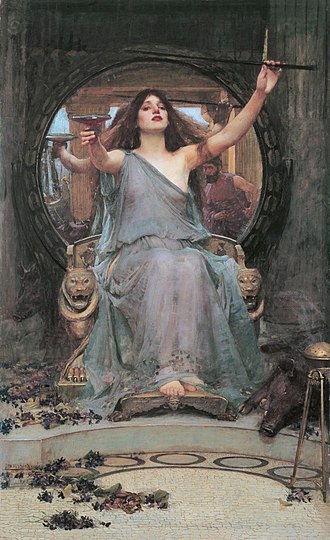

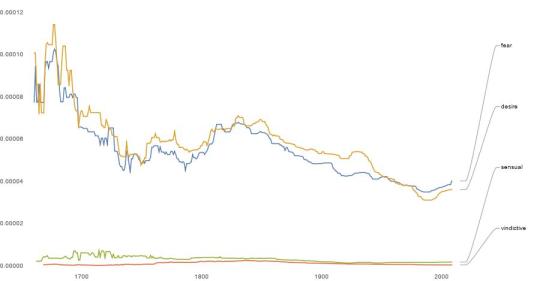

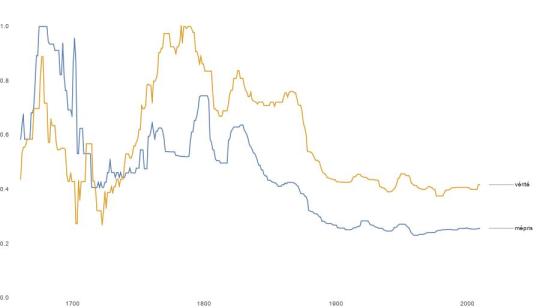
Circe
The enchantress who lives isolated on an island;
She who is renowned for her knowledge of potions and herbs;
creates the content and lures any to her home;
transform them for their good or bad into animals;
a figure of fear as well as of desire;
sensual and vindictive;
a figure who transcended her myth;
embodied the metamorphosis;
Circe with the hippie, Circe with the philosophers, Circe with the biologists;
Circe: the alteration.
Circe is an enchantress in Greek mythology. She was renowned for her vast knowledge of potions and herbs. Through the use of these and a magic wand or staff, she would transform her enemies, or those who offended her, into animals.
Odysseus visits her island of Aeaea and she changes most of his crew into swine. He manages to persuade her to return them to human shape, lives with her for a year and has sons by her. Her ability to change others into animals is further highlighted by the story of Picus, an Italian king whom she turns into a woodpecker for resisting her advances. Another story makes her fall in love with the sea-god Glaucus, who prefers the nymph Scylla to her. In revenge, Circe poisoned the water where her rival bathed and turned her into a dreadful monster.
Early philosophical questions were also raised whether the change from a reasoning being to a beast was not preferable after all, and this paradox was to have a powerful impact during the Renaissance. Circe was also taken as the archetype of the predatory female. as a magician and as a type of the sexually-free woman. As such she has been frequently depicted in all the arts from the Renaissance down to modern times.
The episodes of Scylla and Picus added the vice of violent jealousy to her bad qualities and made her a figure of fear as well as of desire.
Circe is initially described as a beautiful enchantress living in a palace isolated in the midst of a dense wood on her island of Aeaea. Around her home prowl strangely docile lions and wolves. She lures any who land on the island to her home with her lovely singing while weaving on an enormous loom, but later drugs them so that they change shape. One of her Homeric epithets is polypharmakos, "knowing many drugs or charms".
In her survey of the Transformations of Circe, Judith Yarnall comments of this figure, who started out as a comparatively minor goddess of unclear origin, that "What we know for certain – what Western literature attests to – is her remarkable staying power…These different versions of Circe's myth can be seen as mirrors, sometimes clouded and sometimes clear, of the fantasies and assumptions of the cultures that produced them." After appearing as just one of the characters that Odysseus encounters on his wandering, "Circe herself, in the twists and turns of her story through the centuries, has gone through far more metamorphoses than those she inflicted on Odysseus's companions."
By the 19th century, Circe was ceasing to be a mythical figure. Poets treated her either as an individual or at least as the type of a certain kind of woman.
The Circe effect, coined by the enzymologist William Jencks, refers to a scenario where an enzyme lures its substrate towards it through electrostatic forces exhibited by the enzyme molecule before transforming it into a product. Where this takes place, the catalytic velocity (rate of reaction) of the enzyme may be significantly faster than that of others.
1 note
·
View note
Text
“The State as apparatus of capture has a power of appropriation; but this power does not consist solely in capturing all that it can, all that is possible, of a matter defined as phylum. The apparatus of capture also appropriates the war machine, the instruments of polarization, and the anticipation prevention mechanisms. This is to say, conversely, that anticipation prevention mechanisms have a high power of transference (...)”. “(...) (W)ar machines have a power of metamorphosis, which of course allows them to be captured by States, but also to resist that capture and rise up again in other forms, with other “objects” besides war (revolution?). Each power is a force of deterritorialization that can go along with the others or go against them (...). Each process can switch over to other powers, but also subordinate other processes to its own power.” (1) “The idea of a constitution (...) involves not only the idea of hierarchy of authority or power but also that of a hierarchy of rules or laws, where those possessing a higher degree of generality and proceeding from a superior authority control the contents of the more specific laws that are passed by a delegated authority.” (2)
It is time for a new humanism. Time to set a place, a forum able to stage the powers of today. Time to call up the ancient, dispose them, squeez them, twist them to reassess todays world. We have lost the meaning of natural proportions, let us look at godly excess. Monotheic religion castrated our apprehension of the world, seeing things either good or bad. The polytheic family encompasses the world and beyond, spinning around our prosaic flatland. A figure founded on intricated concepts is a powerfull constellation naviguating above polysemic ambiguities. As the grand daughter of the Philantropist eponym Elisabeth Murdoch, Elisabeth Murdoch feels the will to engage her vision in the public debat. Since her childhood she was confronted to a rigourous, competitive, mostly manly world. Inspired by her grandmother she cultivated a spiritual friendship with greek feminin characters. Grew up with them. Now her interest does not lie in presenting her various personal relations with them but to stage them.
“(...)(A)dvertising, news, publicity, periodical literature.” This is Elisabeth's inherited background. “(...) They work to a single end: to give the stamp of authenticity and value to the style of life that emanates from the metropolis.They establish the national brand: they attempt to control the national market: they create a picture of a unified, homogeneous, completely standardized population that bears, in fact, no relation to the actual regional sub stratum—although in the course of time it partly succeeds in producing the thing it has imagined.” Take Paris for example: “(...) the Champs Elysées, become the goals of vulgar ambition (and a)dvertisement becomes the “spiritual power” of this new regime.” (3)
“This is the moment when the masterpieces of ancient sculpture are about to appear in all their glory in front of the eyes of France (...) (they) have chosen to live amongst the French, and are to be adored in their living images. Ah! Who would be able to step into the temple of these divinities without saying to himself: these masterpieces, these gods had ceased to be gods for us; the cult of Antiquity had been forgotten; who would believe it?(...); it is Vien, it is David, who then made themselves into their apostles and ministers; it is through them that this great revolution, which has at least given us the hope of creating gods ourselves, has taken place in the arts.” (4)
The time of revolution is now back but as Foucault said : “il faut avoir une méfiance absolue et totale à l'égard de tout ce qui se présente comme un retour. L'une des raisons de cette méfiance est logique : il n'y a jamais, en fait, de retour.”(5) Therefore the story of Elisabeth's friends will intentionally follow the unfaithfull path. In Momus from Alberti “the extended climax (of the seventh book) occurs in an urban theater where the gods act as their own effigies(, Alberti) repeatedly uses the word persona (and so will we) (“mask” or “personality'') to underline the false, theatrical behavior of his characters.” (6)
“Or, as is the case now, the mask assures the erection, the construction of the (new) face (of Elisabeth), the fascialization of the head and the body: the mask is now the face itself, the abstraction or operation of the face. The inhumanity of the face.” (1)
So be it. Let them be the masked actors of a twisted tragedy, trapped in their performance, speculating above our heads, fertilizing our ground. A spectacle of a new kind. Let them play, individually, together, contradict each other, themselves. Let them work as technologies, systems, embedded in concepts and rituals. “They (a)re living geometry, lines and curves of color, entwined into a coalescing whole yet maintaining distinct identities.” (7)
Three personas. Pandora, Circe, Metis. Not the ones we usually know. Their Alter Ego. The ones who stand up, do not apologize. This is Elisabeth's Friends. Pandora has inherited a box, a jarre which contains unspeakable truth. She knows now how to sort things, pick up elements, unleash others. Circe masters metamorphosis by exploring with drugs and potions. She learned to articulate her recipes and to play with the right parameters and Metis is renowned for his wiseness and cunning, making problems no longer valid. As a constellation, they are powerful. As a unity, they can deal with the plenty, transform it. As an unfaithful story, it accesses the realm of discussion. As statuses, they need a sophisticated territory from which to operate, a palace.
Three Faces where “(i)t is not the individuality of (each) face that counts but the efficacy of the ciphering it makes possible, and in what cases it makes it possible.(...) The face is a surface, (...) the face is a map.” (1 ) “How disappointing this answer seems to be! We asked what was the origin of Ideas and where problems come from: in reply we invoke throws of the dice, imperatives and questions of chance instead of an apodictic principle; an aleatory point at which everything becomes ungrounded instead of a solid ground.” (8)
“For each genre, now, the problem will be to decide whether its audience is such as to demand utility or delight or both, and what brand of either of these will be acceptable to it.” (9) To anchor ourselves we will now deepen our reflexion in space with Alberti and Vitruve. But keep in mind : “The mathematics that is needed here is of a new brand.” (10) Their concept and ideas of proportions being a fertile ground from which we should elevate.
This palace will be a theater, a circus and a amphitheater, simultaneously, as the temple of our time, able to adapt to change, suitable to glorify the unknown. If we follow Alberti and Vitruve who compare the three typologies as such: “(...) (W)e will describe both manners of spectacles. In the first, which is for the delight of peaceful times, are introduced the poets, musicians, and actors. In the second, which regard the studies of war, are performed different kinds of duels and contests having to do with bodily strength and dexterity.To the former is dedicated the theatre, a name which means both ‘spectacle’ and ‘a place to watch’.To the latter, which are spectacles of agility and dexterity such as running or jumping, is dedicated the circus. To events such as assaults and fights against animals or men is dedicated the amphitheatre. There are some things that are proper to all of these spectacles: first, that they are horn shaped and curved; next, that they have an open space in the middle; and finally, that they have steps all around and raised places where people can sit and watch.” (11) “But then they differ as to the Form of the aforesaid Area; for those which have this Area in the Shape of a Moon in its Decrease are called Theatres, but when the Horns are protracted a great Way forwards, they are called Circusses, because in them the Chariots make a Circle about the Goal.” (12) So if we follow them and we free this typologies from their form, we can imagine a place which could embody the spectacle. The Palace of Spectacle.
This Palace will be entered through a garden where a fountain lies at its very center. Heron's Fountain one could claim. Another form of spectacle.
1) Deleuze Guattari, A Thousand Plateaus
2) Hayek, The Constitution of Liberty
3) Mumford, The Culture of Cities
4) Harrison Wood Gaiger, Art in Theory 1648 1815
5) Foucault, Le savoir, le pouvoir et l'espace
6) Alberti, Momus (Preface)
7) Asimov, Complete Robot Anthology
8) Deleuze, Difference and Repetition
9) Weinberg, A History of Literary Criticism in the Italian Renaissance 1
10) Ayache, The Blank Swan
11) Williams, Daniele Barbaros Vitruvius of 1567
12) Alberti, 10 books of architecture 1755
-----------------------------------------------------------------
Further quotes:
Vitruve
these vessels - ( poor vessels) large jars made of clay, but similarly resonant
THE plan of the theatre itself is to be constructed as follows. Having fixed upon the principal centre, draw a line of circumference equivalent to what is to be the perimeter at the bottom, and in it inscribe four equilateral triangles, at equal distances apart and touching the boundary line of the circle, as the astrologers do in a figure of the twelve signs of the zodiac, when they are making computations from the musical harmony of the stars. Taking that one of these triangles whose side is nearest to the scaena, let the front of the scaena be determined by the line where that side cuts off a segment of the circle (A B), and draw, through the centre, a parallel line (C D) set off from that position, to separate the platform of the stage from the space of the orchestra.
The circus was based, so it is said, on the heavens
Unlike that of the amphitheater, the central area of a circus was not empty, nor was it filled with a stage, like that of a theater
---------------------------------------------------------------
Alberti
We have dealt with the theater; next we shall discuss the circus and amphitheater.All buildings of this type are derived from the theater: a circus is nothing but a theater with its wings extended along parallel lines, although its nature does not require the addition of a portico; an amphitheater, meanwhile, consists of two theaters, their tiers linked into a continuous circle.They differ in that the theater is a form of semiamphitheater; another difference is that the central area of the amphitheater is quite empty and free of any stage. In every other respect they are similar, especially in their tiers, porticoes, passages, and so on. The amphitheater, we think, was built originally for the hunt; this was why they decided to make it round, so that the wild beast, trapped there and baited, with no corner into which to retreat, would be easier for the hunters to provoke.
The rest of the ornament is taken from the temple
The theater takes the lineament of its area from the hoofprint of a horse.Once this is done, the uppermost portico is built on top. The facade and colonnade of this portico do not receive light from outside, as those we have described below it do, but face instead toward the central area of the theater, as we have mentioned already. This work prevents sound from escaping, and compresses and fortifies it; we shall therefore call the work the circumvallation.
---------------------------------------------------------------------
Perrault (on Vitruvius)
And the Paintings represented three sorts of Buildings, which made three sorts of Scenes, viz. The Tragick by Magnificent Pallaces, the Comick by Private Houses, the Satyrical (i. e. the Pastoral) by Fields and Groves.The Parascenium or Postscenium was the hinder part of the Theater, and the place whither the Actors retired and dressed themselves, and had their Rehearsals, and where the Machines were kept.Near the Theaters, were Publick Walks, in length a Stadium, which is about 90 Perches. There were Trees planted
1 note
·
View note
